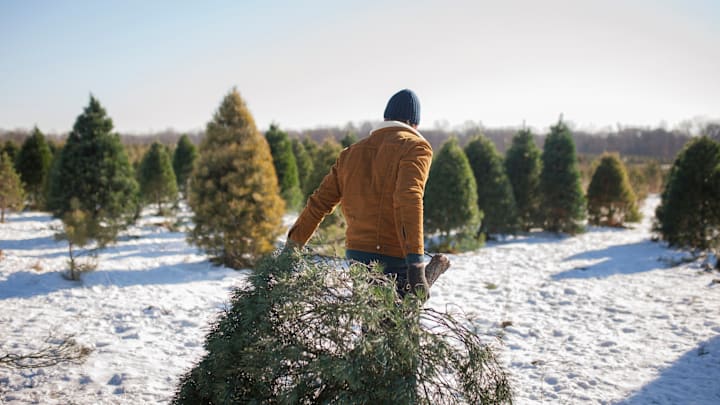If you went out and bought the viral Home Depot Christmas tree this year, you’re one of the 77 percent of Americans who opt for an artificial tree over a live one. But still, this holiday season will see millions of Americans heading to a farm or parking lot (or perhaps even a national forest!), picking out a real live tree, driving it home, and proudly displaying it. It turns out every state produces at least some Christmas trees, but there’s considerable variation in how many.
Where do most Christmas trees come from?
Christmas trees tend to come from specialized farms—not just straight from the woods, as some people think. It takes farmers eight to 10 years to grow trees to their proper size; the plants then all get sold between Thanksgiving and Christmas. Farmers tend to cultivate Christmas trees on land that can’t be profitably used for other crops, known as “marginal land.”
Here are the top 15 Christmas tree-producing states as of 2022, according to the U.S. Department of Agriculture’s Census [PDF]:
Ranking | State | Number of Christmas Trees Cut |
|---|---|---|
1. | Oregon | 4,823,877 |
2. | North Carolina | 3,208,419 |
3. | Michigan | 1,799,391 |
4. | Washington | 936,904 |
5. | Pennsylvania | 721,480 |
6. | Wisconsin | 601,199 |
7. | Virginia | 578,777 |
8. | New York | 318,745 |
9. | Ohio | 189,240 |
10. | Minnesota | 153,600 |
11. | California | 130,730 |
12. | Vermont | 127,121 |
13. | Maine | 94,425 |
14. | Connecticut | 88,893 |
15. | New Hampshire | 79,323 |
Oregon is far and away the top Christmas tree grower. There, the industry is worth $110 million, which makes it the state’s 14th most valuable agricultural commodity. North Carolina is a close second. Although they’re in vastly different parts of the country, both have mountainous climates, which are best for growing the trees.
There are different variations of Christmas trees. On the East Coast, you’re most likely to encounter the balsam fir, which you’ll recognize by the resin-filled blisters on the bark. (Though North Carolina has its own claim to fame: the Fraser fir.) On the West Coast, the Douglas-fir is more common, known for its sweet smell. In the Pacific Northwest states—which altogether grow one-third of the Christmas trees in the country—many of them are noble firs. The trees are great for those who insist the holiday season starts on November 1 because they can hold their needles for a long time.
A Brief History of Christmas Trees in the United States
As Time reports, Christmas trees have been around since the 15th century. The first U.S. Christmas tree market was established in New York City in 1851; back then, many of the trees came from New England. Canada also exported the plants to the U.S. and was responsible for 25 percent of American Christmas trees by the mid-20th century.
A state that doesn’t even make today’s top 15—New Jersey— is to thank for cut-your-own Christmas tree farms. In 1901, farmer W.V. McGalliard planted 25,000 trees, let them grow for seven years, then sold them for a dollar apiece.
During the early 20th century, there were plenty of Christmas tree farms, but many were used for other purposes throughout the year. Americans were cutting five million annually by around 1912, with one in four families displaying a Christmas tree in their home. Tree production continued booming from there.
In 1948, the U.S. Department of Agriculture determined that 28 million Christmas trees were coming from 100,000 acres of land throughout the country. At the time, Pennsylvania made up 40,000 of those acres. It wasn’t until the late 1950s that North Carolina really got into the Christmas tree game. Oregon started taking over when they perfected the nice-smelling Douglas-firs in the 1970s. But fake trees had come on the scene by then and started stealing a lot of natural tree sales.
Whether real or fake, a beautifully decorated tree is a staple for Christmas celebrations all over the country. If you opt for a natural fir, knowing where it came from and its species may help you understand more about what you’ve brought into your living room (and how to take care of it).
Read More About Christmas:
